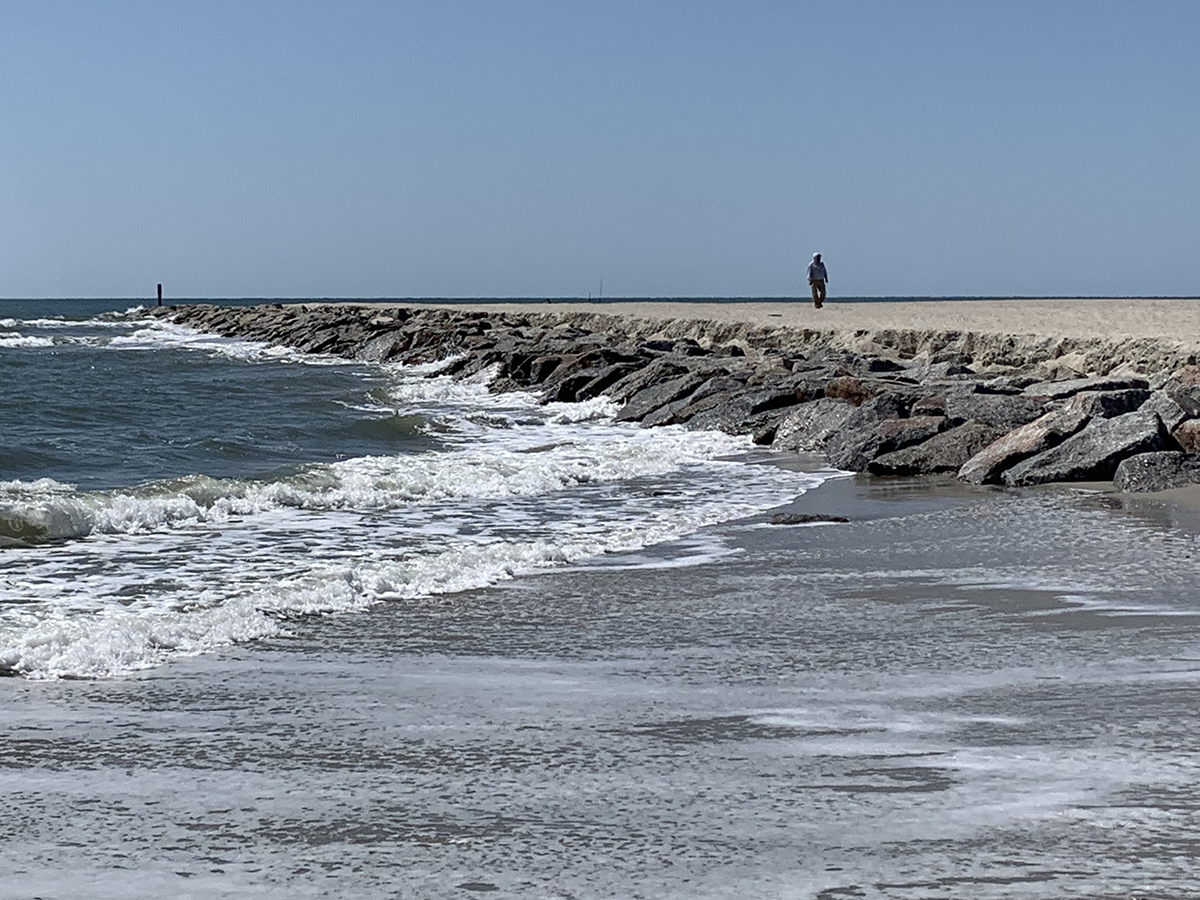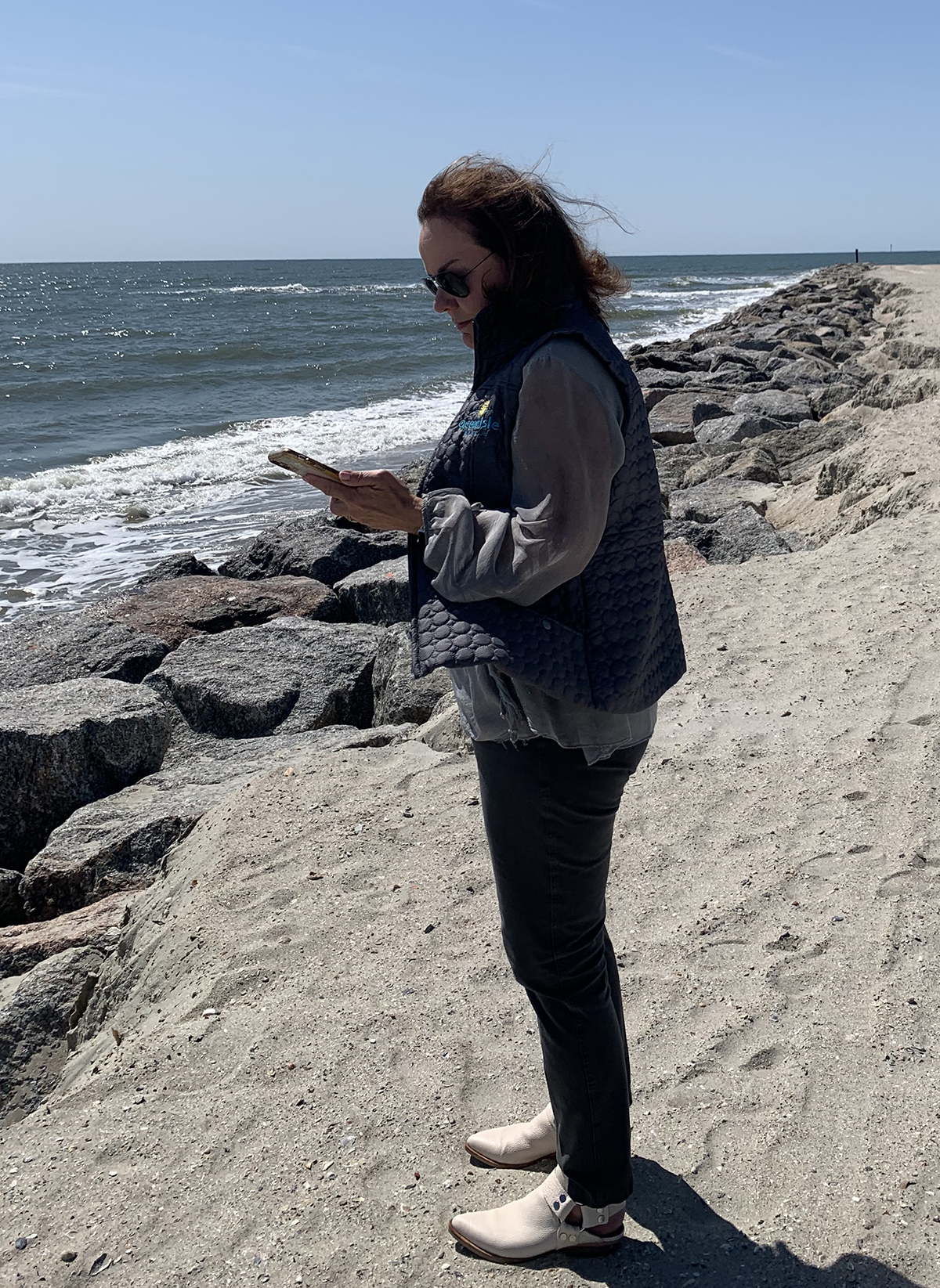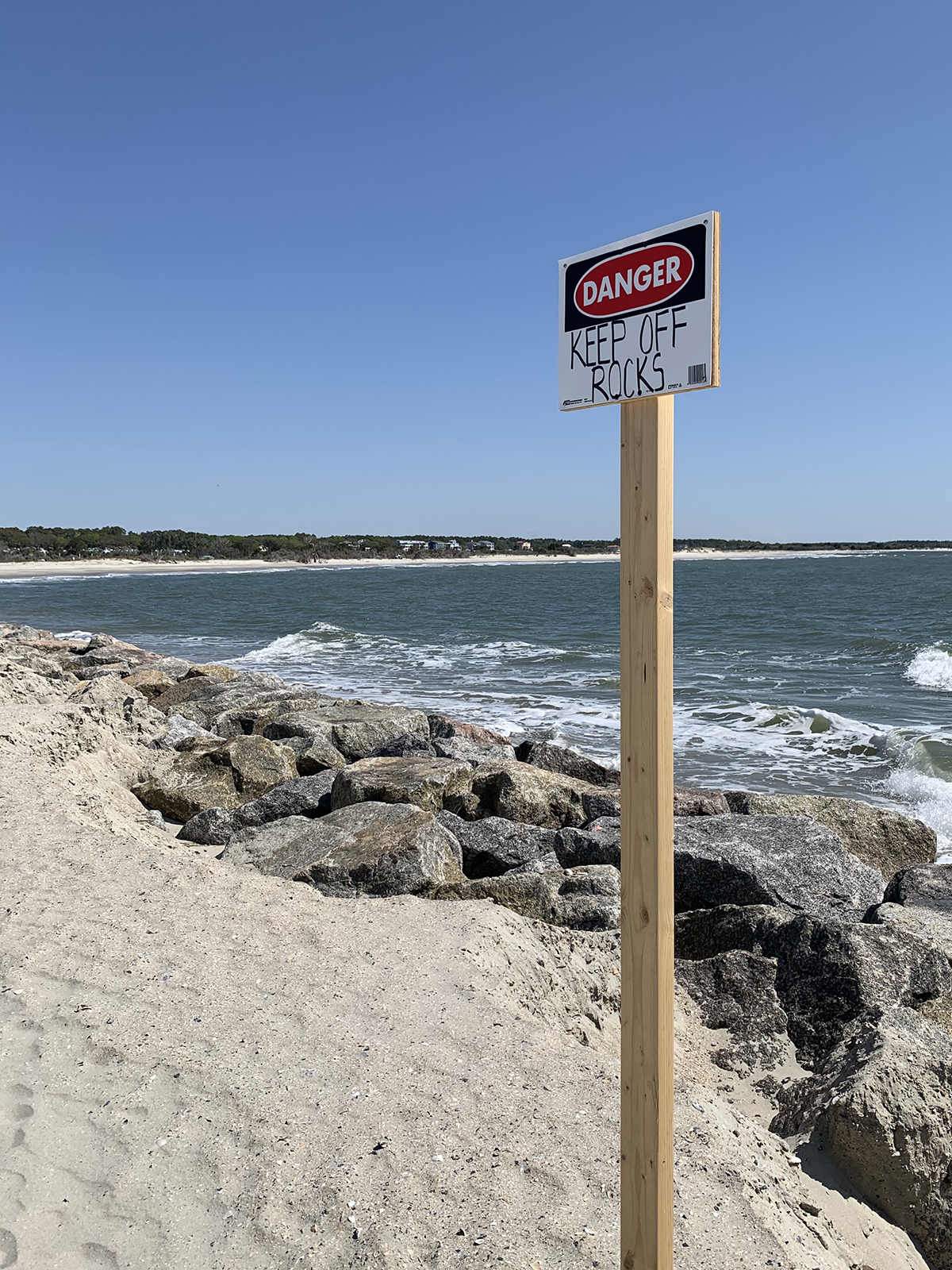
OCEAN ISLE BEACH – More than a decade, a lawsuit and a couple of extra million dollars later, the terminal groin on the east end of Ocean Isle Beach is complete.
Construction of the 750-foot-long groin officially wrapped earlier this month.
All that’s left to be done is getting equipment used during construction off the Brunswick County island. That’ll be done by week’s end if not sooner, certainly by the April 30 deadline.
The beach at the east end, where the island rounds to Shallotte Inlet, has a dramatically different look than it had in years past. A robust sand beach stretches some 200 yards or so between homes the terminal groin. Those homes had been dangerously close to the ocean.
A wall of massive rocks extends along shore out into the Atlantic Ocean. The beach here has been built up so that it is aligned with the top of the terminal groin.
The structure has attracted curious beachgoers and fishermen, so much so that the town has posted temporary signs warning them to look, not touch.
“We’ve ordered bigger, permanent signs,” Ocean Isle Beach Mayor Debbie Smith said after hanging up a cell phone call to a town employee.
The call was made on a recent, sunny, clear-sky morning as Smith, who offered a tour of the east end and the erosion-mitigation structure designed to keep an encroaching ocean at bay. She had called to alert the employee that a couple of “Keep off rocks” signs posted along the beach behind the terminal groin were laying on the sand.

Several hundred yards away, a small crew planted sea oats in uniform lines well back from the ocean tideline. Beach grass is to be planted in the fall.
“We’re going to put bales of hay to encourage dune building,” Smith said.
The town originally planned to install sand fencing as a way to build up dunes, but there is none for sale because of supply shortages, she said.
Portions of a wall of sandbags that stretches some 1,500 feet long remain stacked on the beach near homes. The bags are owned and maintained by private property owners. They were notified by letter a few weeks ago that they will now either have to remove the bags or cover them up.
Town-owned sandbags were covered once construction on the terminal groin began.
The bags have been part of an ongoing, seemingly last-ditch effort to keep the ocean from overtaking more properties at the east end.
The N.C. Department of Transportation abandoned the end of East Second Street years ago.
“There used to be a first street out here too,” Smith said as she drove toward the island’s eastern edge.
About a mile of the east end from the inlet down the ocean shoreline suffers most from erosion, Smith said, over the years claiming homes, damaging and destroying public utilities and roads.
The groin, a wall-like structure built perpendicular to the ocean shoreline, is designed to stop the movement of sand.
This function of terminal groins may be beneficial to the beach immediately behind it, but opponents argue the structures can create erosion problems downstream because they cut off natural longshore drift from reaching those areas.
Ocean Isle Beach is the second coastal town in North Carolina to build a terminal groin since 2011, when the General Assembly repealed a law banning construction of the structures along the coast.
The town’s efforts to install a groin were stalled in August 2017, when the National Audubon Society filed a lawsuit challenging the U.S. Army Corps of Engineer’s approval of the proposed project. The town was later included in the lawsuit.
In late March 2021, a three-judge panel in the U.S. Court of Appeals for the 4th Circuit affirmed a lower court’s decision that the Corps fairly considered the alternatives included in an environmental impact statement examining the proposed project.
Ocean Isle Beach had the necessary state and federal permits in February 2017 to have the terminal groin built so, once the court ruling was handed down, the town put out bids to hire a company to build the groin.
Construction began Nov. 16, 2021. At the same time, a joint project between the town and the Corps began to renourish about 1.5 miles of the easternmost beachfront with an estimated 700,000 cubic yards of sand.
Through the town’s 50-year Federal Emergency Management Act, or FEMA, project with the Corps, sand is injected onto the ocean shoreline about every three years.
“The engineering predicts (the terminal groin) will stretch that out every six or seven years,” she said.

It appears that property owners overwhelmingly support the project. When asked, Smith said she could not think of a single property owner who had spoken against the terminal groin. Opponents of the project, she said, do not own property here.
Despite the lawsuit, David Hill said he had a hunch the terminal groin would eventually be built so he bought a handful of properties on the east end.
“I didn’t have anything down here on the east end until two years ago,” he said. “I watched every one of these rocks go in. I always supported (the terminal groin) because I wanted to keep this beach. The people who don’t think it needs to be here probably don’t know the whole story of this end of the island. This is so needed. I wish it had happened earlier for some of the people who couldn’t save their homes.”
Hill said he was initially worried that sand on the east side of the terminal groin would erode, “but it’s building up.”
The $11 million project was originally estimated to cost somewhere between $9 million and $9.5 million.
The town paid for the project through an account designated for beach projects and funded through a portion of an accommodations tax charged to vacation renters
The groin includes a 300-foot-long anchor, a portion of which is covered by sand.
“It’s anticipated that the natural flow of the sand will cover this up,” Smith said, looking at the wall of rocks that were delivered on flatbed trucks from a quarry outside of Rockingham. That’s the case for the terminal groin on Bald Head Island, she said.
The Village of Bald Head Island was the first North Carolina coastal town to build a terminal groin after the state law was repealed to allow up to six groins to be built on the coast.
Bald Head’s terminal groin was completed in early 2016. The latest monitoring report, which tracked the performance of the terminal groin between May 2020 and May 2021, concluded that the structure was performing “as intended – and as predicted.”
The monitoring report was conducted by Jacksonville, Florida-based Olsen Associates Inc.
A village spokeswoman said in an email that Erik Olsen confirmed the groin continues to perform as intended and predicted.
North Topsail Beach in Onslow County is in the process of having an environmental study prepared for a proposed terminal groin at New River Inlet, a project that may be years out still in that town.
"complete" - Google News
April 26, 2022 at 11:09AM
https://ift.tt/YQF5slo
Construction of Ocean Isle Beach's terminal groin complete | Coastal Review - Coastal Review Online
"complete" - Google News
https://ift.tt/o6nOrXs
https://ift.tt/UEyTFBf

No comments:
Post a Comment